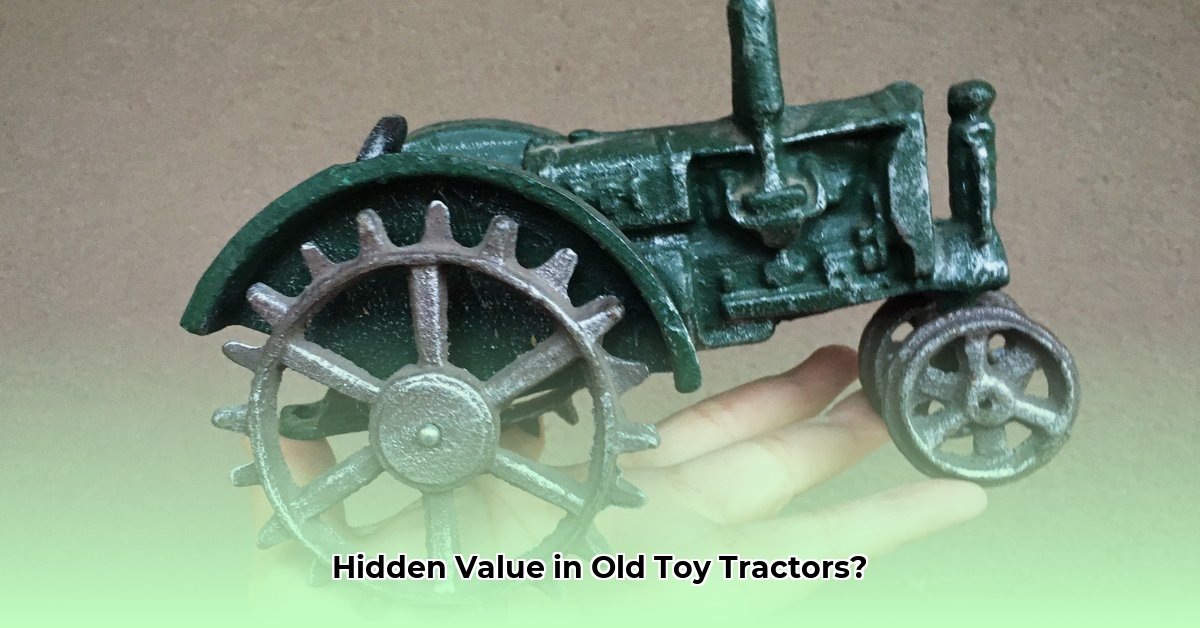
Antique Toy Cast Iron Tractors: A Collector's Guide
Discovering a rusty old cast iron tractor in your attic could unearth surprising value. Many hold significant worth, transforming a simple find into a collector's item. This guide helps unlock the secrets of these miniature metal marvels. For more on Ford tractors, check out this helpful resource.
Identifying Your Treasure: A Detailed Look
Before assessing value, identify your find. Examine it closely for markings—often cast directly into the metal—indicating the manufacturer and age. Note original paint or decals; their condition significantly impacts value. Don't discard anything; even damaged tractors can be valuable to collectors. Every scratch tells a story, adding character and historical significance.
Top 5 Brands of Antique Cast Iron Tractors
Certain brands are more sought-after, commanding higher prices. Five prime examples are:
- IHC (International Harvester): Instantly recognizable, these classic designs are highly collectible.
- John Deere: Legendary in agriculture, their toy tractors are highly desirable.
- Allis-Chalmers: Sturdy designs, particularly valuable in excellent condition.
- Fordson: Timeless appeal adds to their collectible value.
- Ertl: While not always cast iron, their vintage tractors are highly sought after for quality and detail.
Assessing Condition and Value
Condition dramatically impacts value. Collectors use grading systems (similar to coin grading) to assess condition. A "Mint" tractor is virtually new, while "Poor" shows significant damage. Online resources explain these systems. Rarity is also key; a rare tractor, even in fair condition, will command a higher price than a common model in mint condition.
Did you know? A pre-1940's tractor in excellent condition can fetch prices far exceeding those of newer models, even from well-known brands.
Researching Manufacturers and Models
Once identified, research the manufacturer and model. Online forums, auction records (like eBay), and specialized books provide invaluable information on manufacturing dates, production runs, and history. Meticulous research clarifies your tractor's worth and might reveal its uniqueness.
From Garage Sale Find to Auction Block: Selling Your Tractor
To sell, take high-quality photos showcasing every detail, including maker's marks. Write a detailed description highlighting condition and unique features. Honesty builds trust. Consider online auction sites or specialized shows. Researching potential buyers and their price points is crucial for maximizing returns.
Quantifiable Fact: High-quality photographs increase sale prices by an estimated 20%, highlighting the importance of detailed image presentation.
The Upsides and Downsides of Collecting
Collecting antique cast iron tractors, like any hobby, has pros and cons.
| Pros | Cons |
|---|---|
| Potential for significant financial return | Requires research, patience, and storage space |
| Enjoyable hobby, connecting with history and agriculture | Market fluctuations can impact value significantly |
| Building a unique and valuable collection | Finding authentic pieces can be challenging |
| Potential for restoration and customization | Risk of damage during handling, storage, or transport |
How to Determine the Value of Rare Vintage Cast Iron Toy Tractors
This section provides a step-by-step guide:
- Identify the Manufacturer and Model: Research markings to pinpoint the maker and model.
- Assess Condition: Examine the tractor's condition using a grading system. Note original paint, missing parts, and damage.
- Research Similar Sales: Consult online auction sites (e.g., eBay) to find comparable tractors sold recently.
- Consider Rarity: Investigate the production run and unique features to determine rarity.
- Factor in Accessories: Original boxes and decals significantly impact value.
Decoding Value: Age and Origin
Age is a major factor. Pre-1940s tractors command higher prices due to simpler manufacturing techniques, hand-painted details, and the charm of yesteryear. This applies to major manufacturers (like John Deere and IHC) and smaller regional brands.
Expert Opinion: "The age and origin of a toy tractor are crucial factors in determining its collectibility and value," says Dr. Amelia Hernandez, Curator of Agricultural History at the National Toy Museum.
The Manufacturer's Mark: A Sign of Quality
The manufacturer's name signifies quality and history. Brands like Arcade, Hubley, and Ertl are associated with high-quality, detailed castings and durable construction. Don't overlook lesser-known makers; some produced limited-edition models of high value.
Condition: A Collector’s Holy Grail
Pristine condition, with original paint and accessories, fetches the highest prices. Examine the paint, check for rust or damage, and assess the accessories. Small details matter.
Rarity: The Ultimate Value Multiplier
Rarity dramatically increases value. The fewer tractors of a specific model exist, the more valuable it becomes. This relates to production runs and survival rates. Identifying rare variations boosts worth.
Authenticity: Separating Fact from Fiction
Learn to identify authentic pieces, paying close attention to casting quality, paint application, and detailing. Compare your tractor to known originals using online resources or reference books.
Beyond the Numbers: The Story Behind the Tractor
Remember the historical context. These aren't just toys; they represent farming history, manufacturing techniques, and family memories. This adds depth and appreciation to your find.